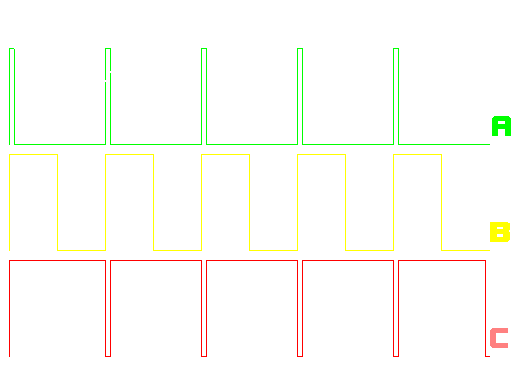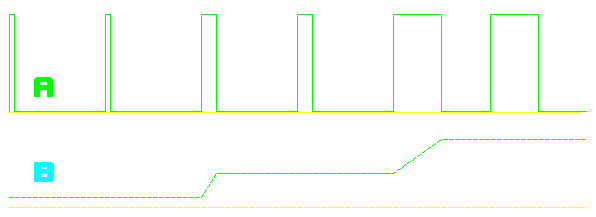Amplifiers - Class of Operation
Most mobile amplifiers use complementary transistor pairs to drive the speakers. In this configuration there is a transistor (or group of transistors) which conducts current from the positive power supply voltage for the positive half of the audio waveform and a different transistor (or group of transistors) which conducts current from the negative power supply voltage for the negative half of the waveform. There are some amplifiers which use the same transistor(s) to drive both the positive and the negative halves of the waveform.
NOTE:
Amplifiers in classes A, B, and AB operate their output transistors in a 'linear' mode. Class 'D' amplifiers operate their outputs in 'switch' mode.
Amplifier Modes of Operation
Linear mode:
Imagine that you are the amplifier's output device(s) and you must support a 10 pound iron weight (the speaker load). The most difficult method (linear mode) would be to hold the weight straight out in front of you. This would very roughly simulate the linear mode architecture. Your muscles would start to ache in a short amount of time. Think of this pain as the power dissipation in output transistors.
Switch mode:
In this example, you can support the weight in one of two positions. In the first position, you can hold the iron weight directly over your head with your elbows locked so that you're not really using very much effort to support the weight. In the second position, you would let the weight hang down by your side. This would also use very little effort from your muscles. If you held it directly over your head half of the time and by your side for the other half of the time, it's position would 'average' out to be the same as if you held it out straight in front of you like in the previous (linear mode) example. This would roughly simulate the switch mode which we will discuss later in this page. You can see that with this method (switch mode), there would also be little pain (power dissipation) involved in supporting the weight.
Amplifier Classes
CLASS 'A':
Many class A amplifiers use the same transistor(s) to reproduce both the top and bottom halves of the audio waveform. In this configuration, the output transistor(s) always has current flowing through it, even if it has no audio signal (the output transistors never 'turn off'). The current flowing through it is D.C. A pure class 'A' amplifier is very inefficient and generally runs very hot even when there is no audio output. The current flowing through the output transistor(s) (with no audio signal) may be as much as the current which will be driven through the speaker load at FULL audio output power. Many people believe class 'A' amps to sound better than other configurations (and this may have been true at some point in time) but a well designed amplifier won't have any 'sound' and even the most critical 'ear' would be hard-pressed to tell one design from another.
Note:
Some class A amplifiers use complimentary (separate transistors for positive and negative halves of the waveform) transistors for their output stage.
CLASS 'B':
A class 'B' amplifier uses two transistors (or two groups of transistors). One transistor (or group of transistors) is used to reproduce the top half of the waveform. A second transistor (or group of transistors) is used to reproduce the bottom half of the waveform. In a class 'B' amplifier, there is typically no idle/bias current flowing through the output transistors when there is no audio. In most cases, if the amplifier has no bias potentiometers and it's not a class D amplifier, it's a class 'B' amplifier.
CLASS 'AB':
Class 'AB' amplifiers use two groups of transistors like class 'B' amplifiers. In most respects, class 'AB' and class 'B' amplifiers are very similar. As we said earlier, a class 'A' amplifier is very inefficient. This is not good for a car audio amplifier. Some people believe that class 'B' amplifier can never produce clean audio because their output transistors aren't biased 'on'. A class 'AB' amplifier is generally considered to be the best compromise. A class 'AB' amplifier is a class 'B' amplifier which has a small amount of 'bias' current flowing through the output transistors at all times. This eliminates virtually all of the crossover distortion that's possible with class 'B' amplifiers. The bias current is flowing because the output transistors are always conducting current (even without an audio signal). This differs from a pure class 'A' amplifier in the amount of current flow. A pure class 'A' amplifier typically has an enormous amount of current flowing through its output transistors with NO audio signal. A pure class 'B' amplifier has NO current flowing through its outputs with no audio signal. A class 'AB' amplifier is much more efficient than the class 'A' but without the possible distortion of the class 'B'. MANY of the car audio amplifiers which claim to be a class 'A' amplifier are just a high bias class 'AB' design. These amplifiers are only class 'A' at very low power output levels. At higher power levels, one of the output transistors will switch off while the other output transistor is conducting. I don't want you to think that I am telling you that there are no class 'A' amplifiers. There are a few high quality mobile amplifiers which are a true class 'A' design.
CLASS 'D':
We said that class 'A' amplifiers were VERY inefficient. Class 'AB' amplifiers are also inefficient but are more more efficient than class 'A' amplifiers. Class 'AB' mobile amplifiers are generally 60% efficient when driving a 4 ohm load at maximum power (just before clipping). The reason that these amplifier configurations are inefficient is because there is a difference of potential (voltage) across the output transistors and current flowing through the output transistors. When you have voltage across the device and current flow through the device, there will be power dissipation in the form of heat. The Ohm's Law formula P=I*E expresses this clearly. The power needed to produce this heat is wasted power. When there is (virtually) no voltage drop across a device (whether it's a large piece of wire or a transistor), there can be a significant amount of CURRENT flow through the device with (virtually) no power dissipation. This means that there is virtually no heat given off (highly efficient). The inverse is also true. If you have a significant amount of VOLTAGE across the device (transistor, wire...) but no current flow through the device, again, there will be no wasted power. If you look at the formula P=I*E again, you can clearly see that if you reduce either I or E (I is current, E is voltage) to a value near 0, the power dissipation will be very low.
OK, now to the point. A class 'D' amplifier, which may also be known as a switching amplifier or a digital amplifier, utilizes output transistors which are either completely turned on or completely turned off (they're operating in switch mode). This means that when the transistors are conducting (switched on) there is virtually no voltage across the transistor and when there is a significant voltage across the transistor (switched off), there is no current flowing through the transistor. This is very similar to the operation of a switching power supply which is very efficient.
Output Transistor Switching:
In the diagram below, there are 3 waveforms. Point 'X' is the point where the transistor would be fully 'on', it would be conducting the full power supply voltage.This is the same as taking a piece of wire and connected the rail voltage to the speaker output of the amplifier. Point 'Y' shows that the transistor is fully 'off' and the output voltage is effectively 0 volts. This is the same as completely disconnecting the speaker from the amplifier. The 'duty cycle' of waveform 'A' is approximately 10%. If you averaged the voltage over time, the effective output voltage would be approximately 10% of the power supply voltage. Waveform 'B' has a 50% duty cycle. Waveform 'C' has a 90% duty cycle.

Note:
This diagram (below) shows the effective D.C. output from the respective waveform. Please keep in mind that the effective output voltage is represented as it would be while there is a 'load' on the amplifier's output transistors. If there were no load, the output voltage would stay at the full power supply voltage because nothing would pull the voltage back toward the reference (ground).
Averaged DC Voltage:
You should notice that the longer the output transistors are 'on', the higher the effective output voltage. From a purely mathematical stand point, the output of the top waveform is at 100% of the supply's output voltage for 10% of the time and at 0% (0 volts) for 90% of the time. If we assume that the amplifier has a rail voltage of 40 volts, the output is at 40 volts for 10% of the time and at 0 volts for 90% of the time. This would give you ((10*40)+(90*0))/100 or 4 volts of average output voltage.

In the diagram below, waveform 'A' is the pulse width modulated portion of an audio signal. Notice that it switches between the yellow reference line (ground) to the rail voltage (white line).

Waveform 'B' shows how the voltage is stepped up as the width (time on) of the pulse increases. This part of the signal is not really present at any point in the amplifier. It is simply included for clarity. You should notice how the effective voltage is stepped up as the pulse width increases.

Waveform 'C' is a portion of the sine wave output signal, after passing through a low pass filter. Keep in mind that the pulses are a high frequency square wave, it may be as high as 500,000 hertz. A low pass filter which will allow a 20,000 hertz signal to pass (the highest frequency needed to reproduce the audio spectrum) will have virtually no effect on the audio output signal and will completely filter out the switching pulses.

In the diagram below, notice the circle on the sine wave at the bottom of the drawing. It shows the portion of the sinewave that is being reproduced in the example.

The following animation shows how the pulse width compares to the sine wave equivalent and the angular equivalent (discussed in the amplifier bridging page). You should note that the horizontal scale of the square wave pulses is not accurate. In reality, there might be 1,000-10,000 pulses for one complete cycle of the sine wave (depending on the switching frequency of the amplifier and the frequency of the sine wave). You can see that the pulse width is of a high duration to produce the higher voltage portion of the waveform and of low duration when the voltage is at its lowest point.
The dark blue switching transistors are shown in the semi-transparent amplifier. They produce the square wave pulses. The pulses are then sent to the low pass filter which allows only the demodulated audio signal to pass through to the speaker terminals of the amplifier.
----- Critically Important -----
-
Flash graphics viewing/use alternatives:
-
Flash support by most modern browsers has been dropped but that's not the end of the line for Flash.
There is no practical alternative to Flash for the interactive demos/applets/graphics on this site.. Especially when there are alternatives, some simple, some good, some...
-
Ruffle is chosen by most because they can't imagine using anything but their preferred browser. It works. It's OK but not great. The Flash graphics won't look as they're supposed to but it, generally, works.
-
The #1 preferred (by me) way to view the site and the Flash graphics is with the Chromium Portable browser and the installation of the older (no time-out) Flash Player files. This was incredibly simple when people knew computers but not today when people only know how to work with their phones.
-
The Flash Browser is a good option but it's so stripped down that it makes it somewhat difficult to use.
-
The Maxthon browsers are an option. The v4.95 is the easiest (install and use). V5.3.8 and 6.1.0 require (very) slightly more effort (very).
-
All of these browsers are available from my Flash Information page.
-
The Chromium and Maxthon browsers on the page above are 'portable' browsers. They are not installed into your system. They are simply made available for use on your computer. They can be carried around on a Flash drive and used on any computer.
----- Critically Important -----
|










